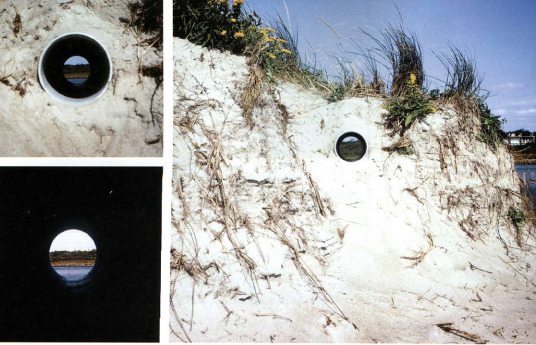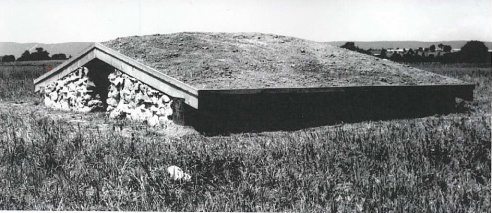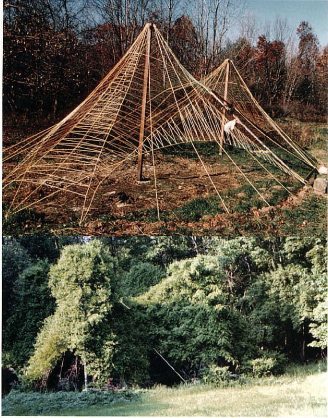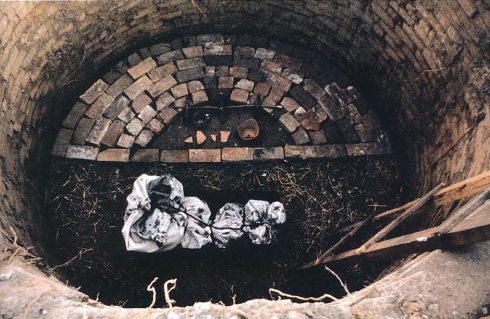Title: Looking at, and Overlooking, Women Working in Land Art in the 1970s (2008)
In New York in the 1970s, widespread desire for anti-traditional forms of behavior and art, surging feminist solidarity, and nascent environmentalism moved innovative women sculptors who worked in nature into a new presence in the art world. Not since Henry James’s 1903 sneer about a “strange sisterhood” of expatriate American “lady sculptors” who “settled upon the seven hills in a white, marmorean flock” had women sculptors received such unifying attention. In the decade between the tumultuous ’60s and the flush ’80s, Cecile Abish, Alice Adams, Alice Aycock, Agnes Denes, Harriet Feigenbaum, Suzanne Harris, Nancy Holt, Mary Miss, Patsy Norvell, Jody Pinto, Patricia Johanson, and Athena Tacha, among others, most based in New York City, began to be recognized as a distinctive contingent within the new genre of Land Art. In a 1978 article, “Six Women at Work in the Landscape,” critic April Kingsley asserted, “Women seem to be making most of the really innovative moves in this art form at the moment.”
Did you know that? Probably not. Think of the most famous sculpture made by a woman in the 1970s, and scrolling through your mental file system will probably pop up Judy Chicago’s The Dinner Party (1974-79), which became the zenith – or nadir, depending on personal/political preference – of the goddess worship central to the decade’s feminist art movement. The historical view of the early to mid-’70s sculptural zeitgeist as being female-coded or conceptual/disembodied seems to have swept women sculptors who used architectural and landscape procedures to focus on phenomenological issues into a kind of Bermuda Triangle of historical invisibility. Last summer, to address that lacuna, the SculptureCenter, Long Island City, presented “Decoys, Complexes and Triggers: Feminism and Land Art in the 1970s,” guest-curated by Catherine Morris.
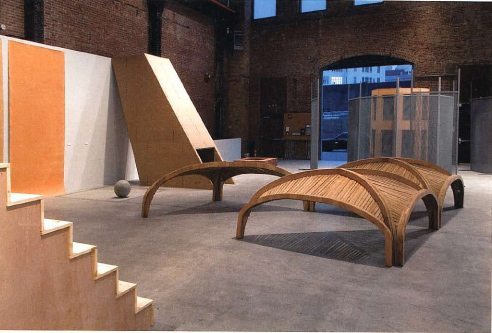
Installation view of “Decoys” with works by (left to right) Alice Aycock, Michelle Stuart, Jackine Winsor, Suzanne Harris, Alice Adams and Miss Mary.
In its first week, “Feminism/Land Art” overlapped with another show focused on the 1970s, “WACK: Art and the Feminist Revolution,” which filled the MoMA/P.S.1 complex down the street. The brief concurrence, and the fact that only Lynda Benglis, of the SculptureCenter’s 10 artists (Alice Adams, Alice Aycock, Benglis, Agnes Denes, Jackie Ferrara, Suzanne Harris, Nancy Holt, Mary Miss, Michelle Stuart, and Jackie Winsor), was on view at P.S.1 made “Feminism/Land Art” into a sort of caboose to “WACK”‘s long train. But a bifurcated inconsistency of “Feminism/Land Art” suggests that the worthy goal of rectifying omissions from “WACK” derailed the focus on Land Art. More important is the real need to fill gaps in art historical memory, specifically of women working in the landscape.
The women sculptors who worked outdoors in the 1970s became active after great notice was given to the earthen excavations, mounds, piles, and markings of Michael Heizer, Richard Long, Dennis Oppenheim, and Robert Smithson, the first generation earthworkers who began delving into distant dirt around 1967. In contrast to those artists’ customary practice of using earth unreinforced by extraneous supports, the next generation of Land artists working in the earth brought wood, metal, and concrete. As Kingsley put it: “Alien materials are brought to the site and something is built with them that is more or less meant to endure through time.”
Works by Aycock, Holy, Miss, and Stuart, the four artists mentioned by Kingsley who also participated in “Feminism/Land Art,” generally confirm that definition. Holt is the archetypal Land artist in terms of the expansive scale of her projects exploring perceptions of space and astronomy. She brought concrete pipes of varying diameters to a Hamptons beach for Views through a Sand Dune (1972); to Artpark in Lewiston, New York, where they sunk into the earth and filled with water for Hydra’s Head (1974); and to the Nevada desert for the solstice-aligned Sun Tunnels (1976). Sun Tunnels and Stone Enclosure: Rock Rings (1977-78) at Bellingham, Washington, may be the only still-extant 1970s outdoor works documented in the show.
Stuart transferred a more fragile medium, paper, to the outdoors in Niagara Gorge Path Relocated, made at Artpark in 1975. After impressing local rocks and earth into muslin-backed rag paper and polishing the surface, she joined the panels to form a 420-inch-long ribbon that unfurled as it rolled down a terraced hillside where Niagra Falls was located at the time of the last glacier, about 12,000 years ago, an earthen remembrance of a former flow. By contrast, her Stone Alignments/Solstice Cairns (1979), which used only rocks from a plateau at the Columbia River Gorge in Oregon to create an astronomically aligned X within a circle with cairns on the perimeter, was an earthwork. Likewise, Denes’s Rice/Tree/Burial at Artpark and dramatic Wheatfield – A Confrontation (1982) at the Battery Park City landfill brought non-indigenous seeds to the sites as a kind of transgressive agriculture. These were very much about positive generative forces through the growth of edible plants in unlikely places.
Aycock’s precise plan for Project for Elevation with Obstructed Sight Lines (1972) exemplifies the importance of participatory discovery of the environment in both earthworks and Land Art. As she wrote on her drawing, “only as the observer completed the ascent of a given slope does the next slope become apparent.” Her 14-foot-high pine Stairs (These Stairs Can Be Climbed) (1974/2008), reconstructed inside SculptureCenter, demonstrated Aycock’s practice of putting the viewer/participant in uncomfortable spaces: when one climbed the stairs the ceiling height prevented ascent to the top. Conforming to the show’s themes, Aycock should also have been represented by photographs of her signature early Land Art: Low Building with Dirt Roof (1973), with its dank earthen hole to crawl around in, and Circular Building with Narrow Ledges for Walking (1976), a scary descent to another pit. Her work is compelling in its experiential perversity, but one had no sense of that from the broad blond staircase at the SculptureCenter.
In comparison, Miss’s inventive designs focusing attention on unmediated spaces and exploring contrasts of enclosed and unobstructed space were well represented in photographs, including Untitled (Battery Park) (1973), a series of panels installed 50 feet apart on rough landfill, with disks cut out to suggest a setting sun, and Perimeters/Pavilions/Decoys (1978), a mini-city of excavated rooms and projecting towers with ladders, on the grounds of the Nassau County Museum in Roslyn, New York. Miss’s plywood and steel mesh Screened Court (1979) demonstrated her characteristic preference for contrasting industrial weave and solidity in abstract forms, as well as a sensibility that thwarted the viewer’s ability to penetrate to the center, akin to the frustrations perpetrated by Aycock in works such as Wooden Post Surrounded by Fire Pits (1976).
Aycock’s and Miss’s early works were very architectural in structure, a fact that Lucy Lippard brought to attention in her 1979 article “Complexes: Architectural Sculpture in Nature,” probably the source of curator Morris’s use of “Complexes” in her exhibition title. Of the seven women Lippard discusses, three were included in the show: Aycock, Harris, and Holt. Documentation of Harris’s Locus One Up, built in 1976 on the sand and rock landfill of the future Battery Park City, would have been more appropriate to the Land Art theme than the boxy interior-scale works chosen by Morris. As Lippard described it, “One entered a temporary shelter, an underground passageway that led to a doubled experience: absolute enclosure (in a solid white cube nearly filling the circular well) and open expanse (the sky seen when one looked up instead of ahead).”
Another architectural work on view, Adams’s Large Vault, (1975), a series of Gothic rib vaults made of wood lath that arched across the floor, offered an unusual top-down view of a form usually seen from far below. In contrast to Large Vault, which reads as a discrete object, Adams’s Shorings (1979), made of wooden posts barely enclosing a large cube of dirt, puts her in the realm of Land Art. Likewise, Jackie Ferrara’s slatted Reconstruction of Wave Hill Project (1980-2008) resembles the stepped platforms and ziggurat towers of ancient Babylonian, Buddhist, Mayan, Aztec, and other architectural traditions. Rather than plopping this work into the SculptureCenter’s courtyard – neither an act nor work of Land Art – it would have been more thrillingly scary, and revelatory of the genre, to have Aycock re-create one of her low earthen chambers for viewers to experience.
Similarly, one wondered what Jackie Winsor’s Cement Sphere (1971) and Exploded Piece (1980-82), a wood and concrete cube, were doing in a Land Art exhibition. Both inclusions derive from the contradiction in Morris’s exhibition title and the different focus stated in its announcement – “women artists who made significant contributions to the development of sculptural practice in the 1970s.” Winsor did make work akin to Land Art, but instead of 30 to1 Bound Trees (1971-76), the show illustrates a discrete object made of natural matter. An illustration of her 1972 “‘shelter’ or high platform of saplings bound close together with unwound rope” would have been more appropriate. Lippard described this work, nestled within leafy trees and bushes in the woods outside Richmond, Virginia, as “so finely attuned to its natural surroundings that making sculpture outdoors becomes, in turn, a natural process.”
The other women discussed by Lippard were like sisters missing from the reunion staged by Morris. Lippard describes Harriet Feigenbaum’s works at Artyard, Brooklyn, and Art on the Beach in Lower Manhattan; Feigenbaum would go on to remediate a strip-mined site in Pennsylvania (1983). Lippard also describes Jody Pinto’s Triple Well Enclosure (1976), with ladders for descent into what might be a burial chamber or libation pit, and Audrey Hemenway’s trellised and planted Garden Web (1977-78), which was featured in the feminist journal Heresies, in an article on “Environmental Sculpture” that also illustrated and discussed Patricia Johanson’s design for Leaf Garden (1974). Johanson started making site-specific sculptures in nature out of wood or cement in 1968; her subsequent architect’s license gave her comprehensive control as artist/designer of complex environmental remediation projects.
Others making relevant work who were omitted by Morris include Athena Tacha, who in the ’70s created “chiseled mountains stippled with pines and boulders” and expansive, thinly terraced hillsides in public art projects for casual public seating. Another is Patsy Norvell whose Lifeline (1977) “consists of a series of fences of different heights and materials which define paths, creating both boundaries and openings. These different spaces and passageways re-create symbolically the passage of life – time/space that is occasionally easy and flowing and other times cramped and unclear.” And Cecile Abish’s shallow excavations and low heaps, as in 4 into 3 (1974), illustrated in Kingsley’s article, and Shifting Concern (1975), displays the qualities of environmental embeddedness and expansive scale characteristics of Land Art.
In addition to the perplexing omissions, the inclusion of Lynda Benglis is mystifying. But her representation by a signature multicolored spill of polyurethane foam on the floor – a witty exaggeration of Jackson Pollock’s flung and poured paint – reveals a source of the exhibitions contradictions: Morris’s elision of the distinction between ground – unbounded outdoor earth – and the constructed interior space of a floor. That explains the presence of Winsor’s floor-bound braided rope wreaths and low open squares of bricks. But these works contradict the basic identity of Land Art, which is, by definition, outside and environmental. As Kingsley blunted stated, “The innovative art form of the moment doesn’t include large sculptures situated out-of-doors though not site dependent.”
The exhibition provided no clue as to what either Morris or the artists themselves think of their works’ relation to either feminism or nature. Coincidentally, yet another feminism survey exhibition last summer, “Making It Together: Women’s Collaborative Art and Community,” curated by Carey Lovelace at the Bronx Museum of Art, included Mary Beth Edelson’s 1976 photograph of the feminist Heresies collective showing Mary Miss and Michelle Stuart. We can be sure that the women making Land Art, as vanguard artists in a cutting-edge milieu, were aligned in various ways, intellectually, socially, with feminism. But the works in the show, and Land Art by women in general, do not display an explicit relation to gender and sexuality in their subject matter. Holt and Stuart encouraged a connection between viewers and the cosmos through solstice alignments; Aycock’s dark crawl spaces may be constricted wombs, but her mazes or forests of poles that we can’t enter evoke emotional aloofness. Denes planted crops to feed the world and later trees to sustain it, and Feigenbaum, Pinto, and especially Johanson designed environments to sustain and recycle natural resources for the public good while providing visually stimulating recreational areas. But spatially and materially, a number of women sculptors’ oeuvres are not distinctly feminine: the large scale of the works, the rough, industrially associated materials, the architectural forms, and the constructive procedures are aspects traditionally associated with masculinity.
Consider the gender androgyny implied in Kingsley’s analogy between the development of Land Art and American territorialism. Writing of 1960s earthworkers as “pioneers” who “scouted” the new genre, she wrote, “Just as women shouldered half of the backbreaking workload of civilizing the wilderness in those early days of our country, so do they now share equally with male artists in this new wave of creative intellectual domination over nature.” So, on the one hand, the large number of women who worked in Land Art in the ’70s evokes an archaic identification with the dyad of women and nature. But on the other hand, their creation of abstract and architectural forms on land, followed by their development into designers of large-scale, constructed public environments, suggests an antipathy to earth mother codification in favor of alignment with (male) culture’s manipulation of nature as Other. Despite this being a decade after the publication of Rachel Carson’s Silent Spring, few of these ambitious male and female artists (Alan Sonfist was the exception) directly connected their works or themes to political environmentalism. The women’s position – working in nature but making increasingly complex architectural structures – suggests a gender fusion ahead of the fluidity of subsequent decades, which allowed women artists to predominate in current reparative environmental projects.
Another lack in this exhibition is the contradiction between its focus on the specific decade of the ’70s and on New York City and its absence of historical context. In the first third of the decade, Earth Day was founded, the Vietnam War waned and, along with a Mid-East oil crisis, so did the economy. In the middle third, New York City was on the verge on bankruptcy. By the end of the decade, the economy was picking up, and the return of luscious painterly figuration ushered in a conflicted Postmodernism. Absent reminders of the rough urbanism that these artists worked in – no wonder they went to restorative nature – and with a baffling array of sculptural objects muting the focus on Land Art, without addressing the rich topic of traditional connections between women and nature and its manifestation or rejection in ’70s feminism, the presentation seems desiccated.
Some of the artists identified here as relevant but missing persons in “Feminism/Land Art” are undoubtedly unfamiliar to viewers. With good reason: a few haven’t exhibited much in a couple of decades. Others are now active in public art projects and don’t make gallery-scale works. But this was a historical show, with sources beyond the Chelsea/Biennial/Art Fair circuit, and the artists cited here indicate that these artists were recognized, grouped, and incisively presented by contemporaneous art professionals. Morris and the SculptureCenter had an important insight: that another history of art by women in the ’70s, besides the overtly feminist one, needed to be considered. And knowing how the now-major artists in “Feminism and Land Art in the 1970s” developed, it is interesting to look back and see the way they were, artistically. But many more women than those on view at the SculptureCenter made Land Art, and some of those on view did not. Ultimately, this exhibition will have performed its most important service if its partial view stimulates a more substantial examination of this significant period in the history of sculpture.
Published, in abbreviated form, in Sculpture magazine, November 2008, as ‘Excavating Land Art by Women in the 1970s, Discoveries and Oversights’
WEAD MAGAZINE ISSUE No. 1, CREATING CONNECTIONS
Published August 2010

